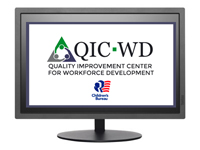Child Welfare Quality Improvement Center for Workforce Development (QIC-WD)
Date of this Version
6-2019
Document Type
Article
Citation
© The Quality Improvement Center for Workforce Development (QIC-WD)
Abstract
For the purpose of the Quality Improvement Center for Workforce Development (QIC-WD), a workforce intervention is a structured set of activities aimed at solving an identified cause of frontline worker turnover. Some interventions, or parts of interventions, have been created in other settings and are being adopted or adapted for the QIC-WD program. Other interventions are being developed collaboratively by the QIC-WD and site implementation teams. All include the four key components that are the hallmark of strong interventions. The four key components of strong interventions include:
1) A description of the theoretical base upon which the actions in the intervention are grounded and which is expanded upon to describe a theory of change for how the intervention can address the underlying issues affecting turnover.
2) A fully articulated set of actions that must occur (and when) as part of the intervention.
3) A description of the kinds of system supports that are necessary to ensure that each action of the intervention occurs and is sustained over time. 4) A summary of evaluation results from previous studies of the intervention including benchmarks that must be monitored as the intervention is rolled out in order to ensure fidelity to the intervention.
Typically, when an intervention is pre-existing, it is important for those adopting the intervention to attempt to follow the intervention as closely as possible. If such strict adherence is not possible, then adoptees must document any modifications of the intervention that are planned. In addition, sites need to monitor how the intervention is being implemented and whether any changes occur in the intervention during the roll-out. When an intervention is being created, it is also important to document all components of the intervention and monitor the rollout in case any changes occur that deviate from the original intervention design. This type of documentation needs to be specific enough to create a “manual.” An intervention manual of this sort describes every component in the intervention including when each step is executed, by whom and in what way. It is important to write an initial intervention manual before the intervention is implemented and to update the intervention manual while the intervention is being implemented to show any changes that occur along the way and how those deviated from the original plan. A final version of the intervention manual needs to capture exactly what happened. It is important to create these manuals at all stages (e.g., pre-intervention, during the intervention and at the completion of the intervention) for several reasons:
- It is important to manualize the intervention before the roll out to help guide the implementation team as they implement the intervention.
- It is important to manualize the intervention before the roll out to help guide the evaluation team as they develop measures of fidelity to the intervention and outcome measures.
- It is important to document changes along the way while the intervention is implemented and upon completion so that evaluators know what they evaluated.
The final manual of the intervention as implemented should include a table showing deviations from the original intervention or the plan for the created intervention. When the evaluation results are reported, it will then be clear what intervention was actually tested. When the evaluation results are published, the reports, presentations and articles will specify both the main components of the intervention and any deviations that occurred so that other sites that attempt to replicate the study of the intervention can be clear as to what the intervention actually is and how the site followed or deviated from the original model. Thus, each of the eight QIC-WD sites need to create a manual for their intervention and modify it during implementation and at the conclusion of the implementation. This manual will describe in detail the four components of a strong intervention noted above.
Included in
Industrial and Organizational Psychology Commons, Public Administration Commons, Social Welfare Commons, Social Work Commons, Work, Economy and Organizations Commons


